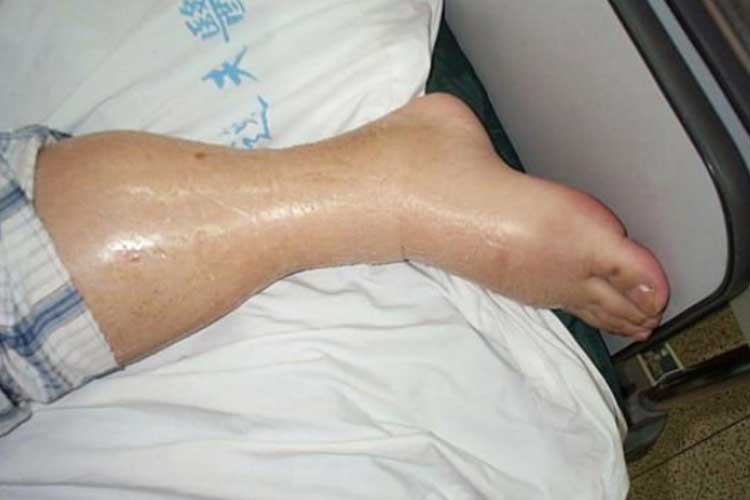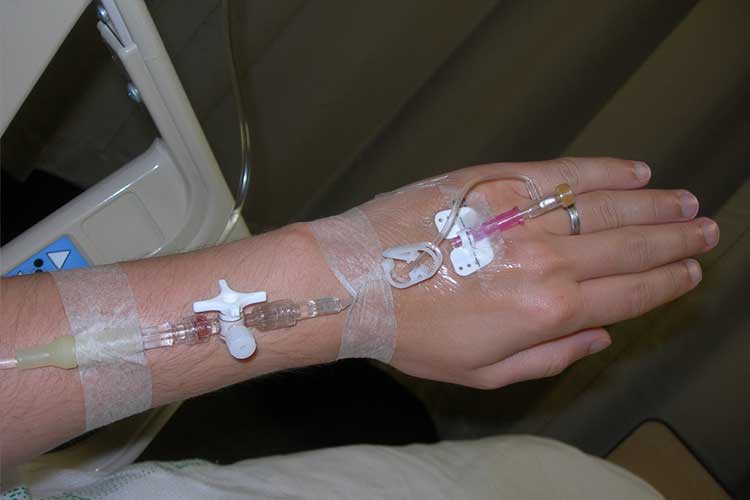Fluid balance charts are an important piece of documentation with a poor reputation.
Despite offering valuable information that may help prevent a patient from becoming seriously ill, healthcare staff are notorious for leaving them incomplete and inaccurate (Lim et al. 2021).
Dehydration is a prevalent issue in hospitals and care settings. Many patients rely on staff to manage their fluid intake, but time constraints and inaccuracies are putting patients at risk (Litchfield et al. 2018).
Fluid balance charts must be accurately completed to determine a patient’s fluid input and output and identify any potential fluid loss or gain that could be detrimental and require escalation of care.
What is Fluid Balance?
Fluid balance, also known as fluid homeostasis, describes the balancing of the body’s fluid input and output levels to prevent fluid concentration from changing (Willacy 2023).
Fluid balance is naturally maintained through thirst when fluid is too concentrated and through urine passage when fluid is less concentrated. However, illness or injury can alter these natural mechanisms, requiring monitoring and intervention (Willacy 2023).
You must ensure patients are adequately intaking and excreting fluid in order to maintain homeostasis.
What is a Fluid Balance Chart?
A fluid balance chart documents a patient’s fluid input and output over a 24-hour period. This information is used to inform clinical decisions (such as medication and surgical interventions) by medical staff, nurses and dieticians, who all expect accurate figures and exact measurements (Georgiades 2016).
When completing a fluid balance chart, you should record the exact quantities of fluid intake by the patient, as well as the type of fluid and the route of administration (e.g, orally, intravenously). For example, if you give the patient a 200 mL glass of water that they consume orally, you will need to record all of that information. You should also keep a running total (Osmosis 2021).
Output (urine, loose stools, vomit etc.) should also be measured in exact quantities (Osmosis 2021).
While the concept of a fluid balance chart seems simple, in practice, it can be difficult, and many issues with the recording process have been identified.

What’s Going Wrong?
Research suggests that nursing staff are not only unaware of the importance of fluid balance, but are also conducting unnecessary monitoring.
A study in 2021 revealed that among 1,497 patients undergoing fluid balance monitoring, 22% had no clinical indication for being monitored (Lim et al. 2021).
Furthermore, the same study found that 23% of the fluid balance charts documented were inaccurate (Lim et al. 2021)..
Yet another study found that although nursing staff acknowledged the importance of fluid balance, monitoring patients’ hydration was ‘one of several competing priorities’ subject to time pressures. Passive, independent patients were found to be the most adversely affected by this, as they had the capacity to manage their own fluid intake but were too anxious to request fluids from staff in fear of seeming ‘difficult’ (Litchfield et al. 2018).
Indications for a Fluid Balance Chart
Even though fluid balance is sometimes monitored unnecessarily, there are a variety of indications for why a patient may undergo fluid balance monitoring. These include:
- Increased fluid output due to:
- Diarrhoea and vomiting
- Increased urine output
- High-output stoma
- Urinary catheter, urostomy or irrigation
- High volume of nasogastric drainage
- Pleural, wound or ascitic drain
- Sweating
- Sustained fever over 38°C
- Decreased oral intake due to:
- Unconsciousness
- Impaired swallowing
- Impaired thirst reflex (e.g. due to older age)
- Receiving enteral feeding or intravenous fluid
- Restricted diet or nil by mouth
- Malnutrition
- Reduced urine output due to:
- Oliguria
- Anuria
- Acute kidney injury (AKI) or chronic kidney disease
- Medications that increase the risk of AKI, including contrast medium, chemotherapy, antibiotic therapy, ACE inhibitors and diuretics
- Reduced independence due to:
- Paralysis
- Vision impairment
- Delirium
- Dementia
- Stroke
- Memory impairment
- Acute illness:
- Heart failure
- Sepsis
- Bowel obstruction
- Acute pancreatitis
- Liver failure.
(Worcestershire Acute Hospitals NHS Trust 2024; Ernstmeyer & Christman 2021)
Positive and Negative Fluid Balance
It’s crucial to use fluid balance charts in order to identify if a patient’s fluid balance is positive or negative, as these imbalances will need to be remedied (Worcestershire Acute Hospitals NHS Trust 2024).
Positive Fluid Balance (Hypervolaemia)
A positive fluid balance indicates that the patient’s fluid input is higher than their output (Worcestershire Acute Hospitals NHS Trust 2024). The condition describing excess fluid is known as hypervolaemia or fluid overload.
Hypervolaemia causes excess fluid in the circulatory system, which may overwork the heart and lead to pulmonary oedema (Tidy 2024).
Causes of Hypervolaemia
- Excessive fluid administered intraoperatively
- Heart failure
- Fluid resuscitation
- Kidney injury.
(Tidy 2024)
Signs and Symptoms of Hypervolaemia
- Pulmonary oedema
- Shortness of breath
- Oedema (swelling)
- Rapid weight gain
- Hypertension
- Heart problems (including congestive cardiac failure).
(Fresenius Kidney Care 2024)

Treating Hypervolaemia
The following are some methods for treating and managing hypervolaemia, depending on the cause and medical advice received.
- Fluid restriction
- Offload the excess fluid - consider diuretics
- Consider dialysis in the case of kidney failure
- Monitor the patient’s heart rate; observe electrolyte imbalances and obtain blood tests
- Support any breathing complications
- Apply continuous haemodynamic monitoring
- Perform an ECG.
(Fresenius Kidney Care 2024)
Negative Fluid Balance (Hypovolaemia)
A negative fluid balance indicates that the patient’s fluid output is higher than their input (Worcestershire Acute Hospitals NHS Trust 2024). The condition describing inadequate fluid is known as hypovolaemia.
Hypovolaemia is caused by significant fluid loss (hypovolaemic shock is defined as a loss of more than 20%), preventing the heart from circulating enough blood around the body. This can result in organ failure. Hypovolaemic shock is life-threatening (Nall 2023).
Causes of Hypovolaemia
- Significant and sudden blood loss (e.g. from wounds, accidents, endometriosis)
- Excessive diarrhoea
- Excessive vomiting
- Excessive sweating
- Surgery
- Severe burns
- Administration of diuretics.
(Nall 2023; Taghavi et al. 2023)
Signs and Symptoms of Hypovolaemia
- Hypotension
- Tachycardia/arrhythmias
- Decreased urine output
- Altered mental state
- Fluid and electrolyte imbalance
- Signs of dehydration
- Cold and clammy skin
(Cleveland Clinic 2022; Taghavi et al. 2023)
Treating Hypovolaemia
- Administer intravenous fluid replacement therapy
- Administer intravenous blood products if required
- Replace electrolyte imbalance
- Support any breathing complications
- Apply continuous haemodynamic monitoring
- Perform an ECG.
(Nall 2023)
If confronted with either kind of imbalance, remember to escalate care if the patient deteriorates and perform basic life support if required. The patient may require critical care services.

Preventing Fluid Imbalance
In order to curb any preventable fluid imbalances, it is crucial to correctly record your patients’ fluid input and output. Having a well-documented fluid balance chart allows nurses to recognise trends that indicate a patient may be heading in a downward spiral.
Early detection of an imbalance will allow appropriate reversal and will reduce the risk of patients being admitted into critical care.
In order for this task to be performed adequately, it is essential that staff are educated about the importance of fluid balance, and that any necessary interventions are made to ensure that the process is completed properly.
Test Your Knowledge
Question 1 of 3
What is a symptom commonly associated with hypovolaemia?
Topics
Further your knowledge


 Free
FreeReferences
- Cleveland Clinic 2022, Hypovolemic Shock, Cleveland Clinic, viewed 13 May 2025, https://my.clevelandclinic.org/health/diseases/22795-hypovolemic-shock
- Ernstmeyer, K & Christman, E 2021, ‘Chapter 15 Fluids and Electrolytes’, in Nursing Fundamentals, Chippewa Valley Technical College, viewed 13 May 2025, https://www.ncbi.nlm.nih.gov/books/NBK591820/
- Fresenius Kidney Care 2024, Understanding Hypervolemia and Fluid Overload, Fresenius Kidney Care, viewed 13 May 2025, https://www.freseniuskidneycare.com/thrive-central/hypervolemia
- Georgiades, D 2016, ‘A Balancing Act: Maintaining Accurate Fluid Balance Charting’, HealthTimes, 7 December, viewed 13 May 2025, https://healthtimes.com.au/hub/nutrition-and-hydration/42/practice/nc1/a-balancing-act-maintaining-accurate-fluid-balance-charting/2167/
- Lim, SH, Lim, ML, Aloweni, FAB & Ang, SY 2021, ‘Audit of the Appropriateness and Accuracy of Fluid Intake and Output Monitoring: Experience in a Tertiary Hospital’, BJN, vol. 30, no. 11, viewed 13 May 2025, https://www.britishjournalofnursing.com/content/professional/audit-of-the-appropriateness-and-accuracy-of-fluid-intake-and-output-monitoring-experience-in-a-tertiary-hospital/
- Litchfield, I, Magill, L & Flint, G 2018, ‘A Qualitative Study Exploring Staff Attitudes to Maintaining Hydration in Neurosurgery Patients’, NursingOpen, vol. 5 no. 3, viewed 13 May 2025, https://onlinelibrary.wiley.com/doi/full/10.1002/nop2.154
- Nall, R 2023, ‘Hypovolemic Shock’, Healthline, 15 November, viewed 13 May 2025, https://www.healthline.com/health/hypovolemic-shock
- Osmosis 2021, Monitoring Fluid Intake and Output: Clinical Skills Notes, Elsevier, viewed 13 May 2025, https://www.osmosis.org/learn/Monitoring_fluid_intake_and_output:_Clinical_skills_notes
- Taghavi, S, Nassar AK & Askari, R 2023, Hypovolemic Shock, StatPearls, viewed 13 May 2025, https://www.ncbi.nlm.nih.gov/books/NBK513297/
- Tidy, C 2024, Fluid Overload, Patient, viewed 13 May 2025, https://patient.info/doctor/fluid-overload
- Willacy, H 2023, Osmolality, Osmolarity and Fluid Homeostasis, Patient, viewed 13 May 2025, https://patient.info/treatment-medication/osmolality-osmolarity-and-fluid-homeostasis-leaflet
- Worcestershire Acute Hospitals NHS Trust 2024, Fluid Balance Guideline, National Health Service, viewed 13 May 2025, https://apps.worcsacute.nhs.uk/KeyDocumentPortal/Home/DownloadFile/3226
 New
New 
